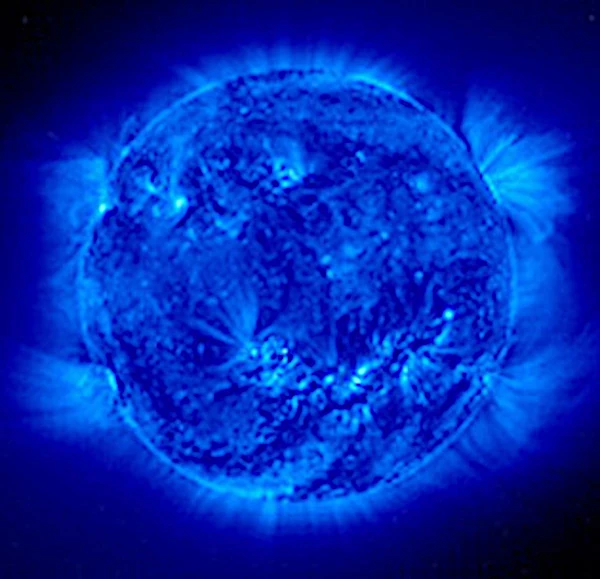
The Sun, which we perceive as yellow from Earth's surface, reveals a completely different chromatic identity when observed in the ultraviolet spectrum. Unlike its familiar appearance that inspired its designation as the "yellow star," the Sun actually appears as an intense blue when examined in ultraviolet wavelengths.
The blue Sun of the ultraviolet reminds us that reality often surpasses appearances. This chromatic duality is not a contradiction but rather evidence of the complexity of the astrophysical processes at work. While our eyes perceive only a tiny part of the electromagnetic spectrum, modern instruments reveal a Sun very different from the one we know—a dynamic, violent, and magnificently complex star, whose study across all wavelengths continues to revolutionize our understanding of stars.
The perception of a star's color fundamentally depends on two factors: its surface temperature and the spectral sensitivity of the observer. The Sun, with a surface temperature of about 5778 K, emits a spectrum that peaks in the green-yellow range, which explains why our eyes, adapted to this spectral range, perceive it as yellowish.
Images of the Sun in ultraviolet do not show a "real blue Sun." UV wavelengths (100 to 400 nm) are invisible to the human eye, so specialized instruments convert these photons into electrical signals.
To make these signals understandable, scientists assign them visible colors. Shorter wavelengths, corresponding to higher frequencies, are represented by blues or purples, while slightly longer wavelengths can be encoded in cyan or green.
This encoding is arbitrary but proportional: the shades of blue translate the distribution of different UV frequencies, allowing our eyes to visualize the intensity and structure of invisible solar emissions.
| Spectral range | Wavelength (nm) | Approximate frequency (Hz) | Assigned color | Comments |
|---|---|---|---|---|
| Extreme UV (EUV) | 10–200 | 1.5 × 1015 – 3 × 1016 | Violet / Light blue | Invisible to the human eye, colors coded to represent areas of strong coronal emission |
| Far UV (FUV) | 200–300 | 1 × 1015 – 1.5 × 1015 | Blue | Representation of the upper layers of the solar atmosphere |
| Near UV (NUV) | 300–400 | 7.5 × 1014 – 1 × 1015 | Cyan / Pale green | Slightly longer photons, visible by instrumental conversion |
| Visible | 400–700 | 4.3 × 1014 – 7.5 × 1014 | Yellow / Orange / Red | Natural colors perceived by the human eye |
| Near Infrared (NIR) | 700–1000 | 3 × 1014 – 4.3 × 1014 | Dark red | Invisible to the human eye, used for thermal imaging |
Sources: NASA – Solar Dynamics Observatory, ESA – UV observations
Observing the Sun at different wavelengths reveals layers and phenomena invisible to the naked eye. Each spectral range provides specific information: the visible spectrum shows the photosphere and the light we perceive daily, ultraviolet reveals the chromosphere and corona, and infrared provides information on temperature and matter movements.
By combining these observations, scientists can study:
In summary, each "color" of the Sun provides a complementary angle to understand its overall functioning. Multi-wavelength observation is therefore essential for predicting eruptions, protecting satellites, and deepening our knowledge of stellar physics.